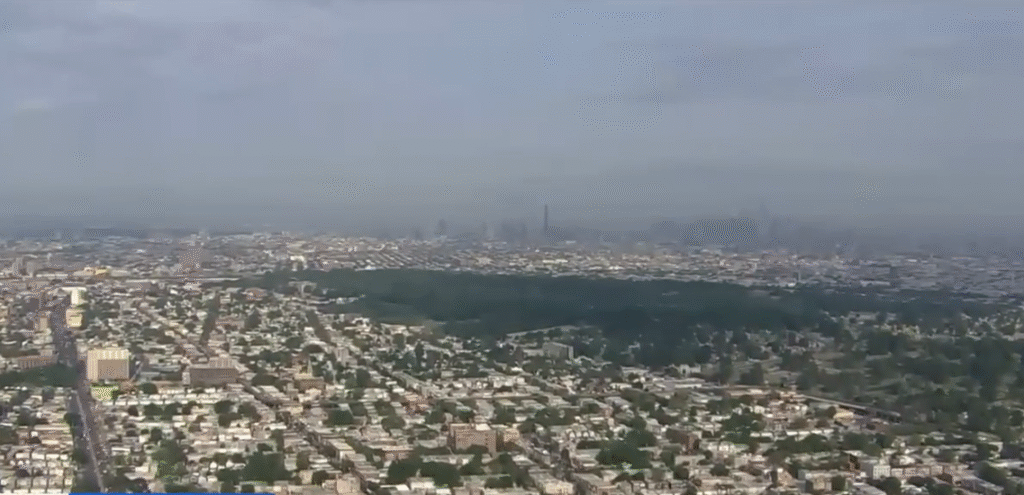New Yorkers gazed up at a dramatically changed sky during the last week of July. A drab, ochre tint took the place of the vivid blue. Dense smoke carried thousands of miles by constant northern winds was the source of that unsettling coloring, not industrial pollution or urban haze. Wildfires that had started in isolated areas of Manitoba and Saskatchewan had created a haze that was so widespread that it covered New York City with particulate matter at a level that is uncommon in the Northeast.
Meteorologists were able to identify abnormally high levels of PM2.5, a type of fine particle that can enter even the healthiest lungs, by using satellite data and surface sensors. Manhattan’s Air Quality Index reached a peak of 136 on July 27. Although that figure may seem intangible, it compelled construction workers to shorten their shifts and mothers to keep their strollers indoors. In addition to being thick, the air was obviously dangerous.
The New York State Department of Environmental Conservation encouraged individuals in vulnerable groups to reduce their exposure through targeted public messaging. Pregnant women, kids, senior citizens, and people with heart or respiratory conditions were among them. This was not hyperbole. In their advisories, doctors from NYU Langone and Mount Sinai noted that there was a marked increase in emergency visits from asthmatic patients during that week.
Air Quality Crisis Bio Table – New York (July 2025)
| Name | Air Quality Alert Event – July 2025 |
|---|---|
| Trigger Event | Wildfire smoke from Canada (Manitoba and Saskatchewan) |
| Air Quality Index (AQI) | 101–150 in NYC – “Unhealthy for Sensitive Groups” |
| Most Affected Populations | Children, elderly, pregnant people, asthmatics, outdoor workers |
| AQI Classification Source | New York State Department of Environmental Conservation |
| Peak AQI in NYC | 136 on July 27, 2025 |
| Reference Website | www.airnow.gov |

Wildfire smoke behaves differently than regular smog, which usually remains low or goes away by evening. Particularly when high-pressure weather systems hold it in place, it persists longer and sinks farther. From Brooklyn to the Bronx, these were the exact conditions that impacted New York’s boroughs, leading to an urban health crisis that developed in real time.
The frequency of wildfire smoke events that impact cities far from their source has increased dramatically over the last ten years. However, this incident was particularly startling. Being unable to breathe outside felt like a strange defeat for a city that takes pride in its ability to withstand adversity, from blizzards to blackouts. Ordinary citizens wanted to know when the air would clear and whether their children could play outside again, while environmentalists pointed to climate trends.
Citing client safety, a number of Manhattan fitness centers temporarily halted outdoor classes in an unusually proactive move. Industrial-grade HEPA purifiers were silently installed backstage by Broadway technicians. Celebrities even raised awareness of the problem by posting masked selfies on social media. Alicia Keys, a singer and native of New York City, said on Twitter that she felt like she was “standing next to a campfire with no escape” while strolling through Harlem that afternoon.
This time, New York’s response was especially creative because of the change in tone. This was handled as a public health emergency rather than merely a weather alert. Real-time AQI readings were displayed on subway billboards. NYC Emergency Management’s app notifications sent out timely alerts, and city parks posted printed health advisories. The public health messaging was very effective and very clear, as evidenced by the decrease in foot traffic.
The impact was less severe for medium-sized cities like Buffalo and Syracuse, but the warnings were still in effect. By midday Thursday, western New York had AQI levels that were classified as “unhealthy for sensitive groups,” according to Buffalo Toronto Public Media. This demonstrated the extent of the impact zone, which extended from Canada into the Eastern Seaboard and the Midwest.
The National Weather Service provided guidance on potential next steps by combining air quality forecasts with weather models. For a few days, northerly winds were predicted to continue, which would allow more smoke to move south. Nonetheless, forecasters maintained a cautious sense of optimism, anticipating that a change in weather patterns over the weekend might provide some respite. Up until that point, the message was consistent: spend less time outside, limit physical activity, and keep yourself informed.
This event was a sharp reminder for policy discussions about climate resilience at an early stage. Fire fallout is no longer limited to western states like California or Oregon. Similar seasonal risks are now present in East Coast urban centers. The conversation is changing to include both fire safety and modifying urban infrastructure to accommodate sporadic air disruptions.
It is recommended that residents check the air quality as frequently as they check the weather. Downloads of apps like BreezoMeter, IQAir, and airnow.gov are at all-time highs. Influencers in the area are endorsing mask brands for their effectiveness in filtering, not for their aesthetic appeal. The cultural shift is unavoidable: air quality is now discussed on a daily basis, much like temperature or subway delays.
This incident is a microcosm of what is to come in the context of increasing climate volatility. It is a reflection of a larger atmospheric pattern that connects local air quality to far-off ecological disasters; it is neither a fluke nor a one-time crisis. In this way, New Yorkers are witnessing firsthand that resilience is about public response, awareness, and preparation rather than just infrastructure.
In order to address similar environmental threats in the future, New York is establishing a standard by promoting data-driven policies and assisting with public health communication. Even though the skies might clear up soon, the effects of this incident will continue to influence policy debates, daily activities in the home, and—literally—the lungs of those who disregarded the warnings.

